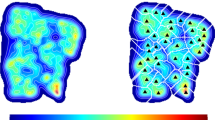Abstract
Progressive sperm motility, describing the directed or linear movement of sperm, is infrequently reported in reproductive studies conducted with rodents. This is a curious circumstance given that progressive motility can be easily reported with current computer-assisted sperm-analysis equipment, and because progressively motile sperm seemingly display a greater likelihood of fertilizing ova than do sperm that move in a random or undefined pattern. This study presents a comparison of the routinely reported total motility (i.e., the percentage of moving sperm cells in a sample) and the progressive motility of sperm from rodents captured at soil-contaminated sites and at habitat-matched noncontaminated reference locations. Progressive motility’s trending with total motility at all areas, in terms of direction of shift, magnitude of change, and degree of correlation, was extremely high. Based on these results and in the interest of assisting ecological health assessments at contaminated sites, it would seem prudent to conduct the empirical research to determine progressive sperm motility’s threshold-for-effect, which may be lower than that for total motility.

Similar content being viewed by others
References
Bucci LR, Meistrich ML (1987) Effects of busulfan on murine spertmatogenesis: cytotoxicity, sterility, sperm abnormalities, and dominant lethal mutations. Mutat Res 176:259–268
Chapin RE, Sloane RA, Haseman JK (1997) The relationships among reproductive endpoints in Swiss mice, using the Reproductive Assessment by Continuous Breeding database. Fundam Appl Toxicol 38:129–142
Gray LE, Marshall JO, Setzer R (1992) Correlation of ejaculated sperm numbers with fertility in the rat. Toxicologist 12:433
Gulati DK, Hope E, Teague J, Chapin RE (1991) Reproductive toxicity assessment by continuous breeding in Sprague-Dawley rats: a comparison of two study designs. Fundam Appl Toxicol 17:270–279
Holson JF, Nemec MD, Stump DG, Kaufman LE, Lindstom P, Bennett JV (2006) Significance, reliability, and interpretation of developmental and reproductive toxicity study findings. In: Hood RD (ed) Developmental and reproductive toxicology: a practical approach. CRC Press, Boca Raton, FL, pp 329–425
Lamb JC, Chapin RE (1985) Experimental models of male reproductive toxicology. In: Thomas JA, Korach KS, McLachlan JA (eds) Endocrine toxicology. Raven, New York, NY, pp 85–115
Meistrich ML, Kasai K, Olds-Clarke P, MacGregor GR, Berkowitz AD, Tung KSK (1994) Deficiency in fertilization by morphologically abnormal sperm produced by azh mutant mice. Mol Reprod Dev 37:69–77
Morrissey RE, Lamb JC, Morris RW, Chapin RE, Gulati DK, Heindel JJ (1989) Results and evaluations of 48 continuous breeding reproduction studies conducted in mice. Fundam Appl Toxicol 13:747–777
Perrault SD (1998) Gamete toxicology: the impact of new technologies. In: Korach KS (ed) Reproductive and developmental toxicology. Marcel Dekker, New York, NY, pp 635–654
Shaw Environmental, Inc. (2006) Draft Phase III & Phase I 2A/3A sites: baseline ecological risk assessment. Picatinny Arsenal, Picatinny, NJ
Shaw Environmental, Inc. (2007) Final installation-wide baseline ecological risk assessment. Longhorn Army Ammunition Plant, Karnack, TX
Sloter E, Schmid TE, Marchetti F, Eskenazi B, Nath J, Wyrobek AJ (2006) Quantitative effects of male age on sperm motion. Hum Reprod 21:2868–2875
Sztein JM, Farley JS, Mobratten LE (2000) In vitro fertilization with cryopreserved inbred mouse sperm. Biol Reprod 63:1774–1780
Tannenbaum LV, Bazar M, Hawkins M, Cornaby BW, Ferguson EA, Carroll LC et al (2003) Rodent sperm analysis in field-based ecological risk assessment: pilot study at Ravenna Army Ammunition Plant, Ravenna, Ohio. Environ Pollut 123:21–29
Tannenbaum LV, Thran BH, Williams KJ (2007) Demonstrating ecological receptor health at contaminated sites with wild rodent sperm parameters. Arch Environ Contam Toxicol 50:459–465
Tannenbaum LV, Thran BH, Williams KJ (2008) Testing the limits of rodent sperm analysis: Azoospermia in an otherwise healthy wild rodent population. Arch Environ Contam Toxicol 56:157–164
United States Environmental Protection Agency (1996) Guidelines for reproductive toxicity risk assessment. EPA/630/R-96-009. Washington, DC
United States Environmental Protection Agency (1998) Health effects test guidelines. OPPTS 870.3800, Reproduction and fertility effects. EPA 712-C-98-208. Washington, DC
United States Public Health Command (Provisional) (2009) Rodent sperm analysis. United States Patent 7,627,434
Working PK, Hurtt ME (1987) Computerized videomicrographic analysis of rat sperm motility. J Androl 8:330–337
Zar JH (1996) Biostatistical analysis. Prentice Hall, Upper Saddle River, NJ
Acknowledgments
The authors thank the United States Army Environmental Command at Aberdeen Proving Ground, MD, for arranging for, and funding the majority of the RSA applications that occurred at training ranges. The authors appreciate the careful manuscript reviews of Dennis Druck and Sherri Hutchens and the editing expertise of Joyce Woods.
Author information
Authors and Affiliations
Corresponding author
Rights and permissions
About this article
Cite this article
Tannenbaum, L.V., Lee, R.B. Correlational Sperm Motility Analysis: Wild Rodent Progressive Sperm Motility as a Potentially Improved Reproduction-Assessment Parameter in Mammals. Arch Environ Contam Toxicol 60, 173–181 (2011). https://doi.org/10.1007/s00244-010-9505-6
Received:
Accepted:
Published:
Issue Date:
DOI: https://doi.org/10.1007/s00244-010-9505-6




